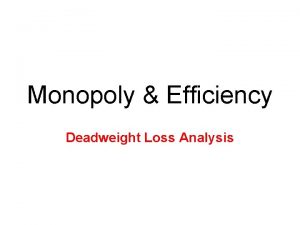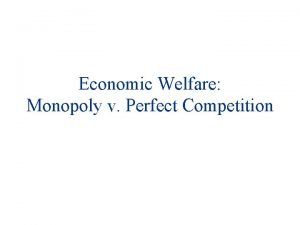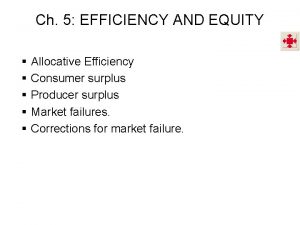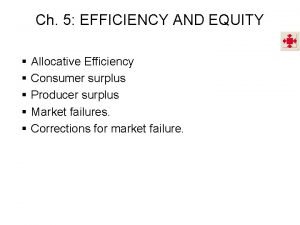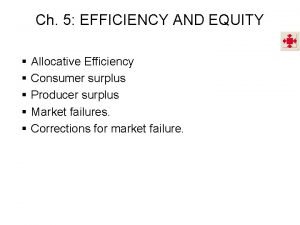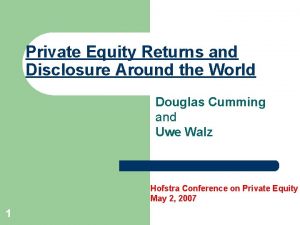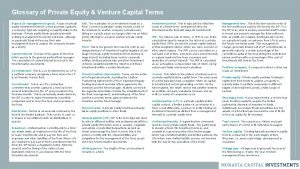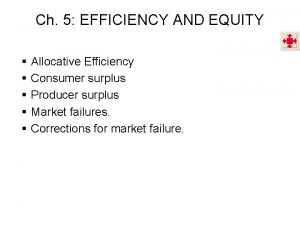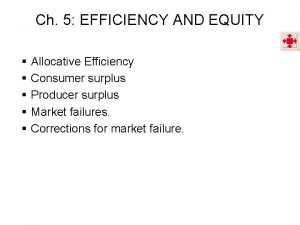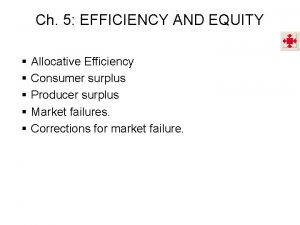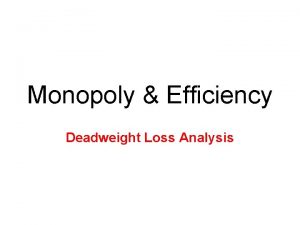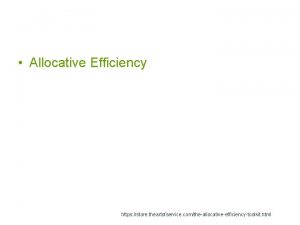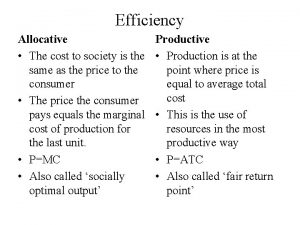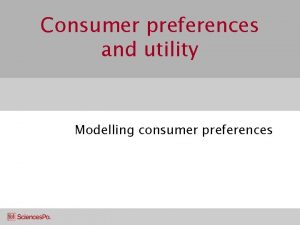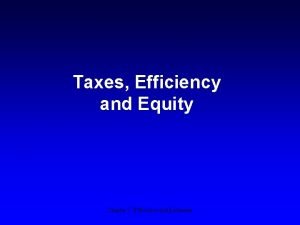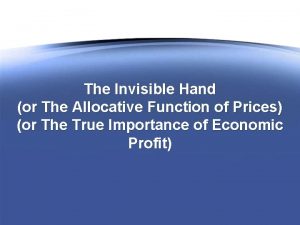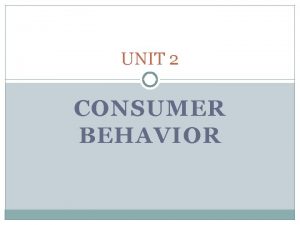Ch 5 EFFICIENCY AND EQUITY Allocative Efficiency Consumer





























- Slides: 29

Ch. 5: EFFICIENCY AND EQUITY § § § Allocative Efficiency Consumer surplus Producer surplus Market failures. Corrections for market failure.

Efficiency and the Social Interest Allocative efficiency § occurs when it is not possible to produce more of a good or service without giving up some other good or service that is valued more highly. § depends on people’s preferences.

Allocative Efficiency • Marginal Benefit § the benefit a person receives from consuming one more unit of a good or service. § the dollar value of other goods and services that a person is willing to give up to get one more unit of it. § decreasing marginal benefit implies that as more of a good or service is consumed, its marginal benefit decreases.

Allocative Efficiency • For any given price, a consumer will buy all units of the good where MB>P • The MB curve will be identical to the consumer’s demand curve. • Market demand curve is summation of individual MB curves P MB Q

Allocative Efficiency • Marginal Cost § the opportunity cost of producing one more unit of a good or service. § the dollar value of other goods and services required to produce one more unit of the good. § increasing marginal cost implies that as more of a good or service is produced, its marginal cost increases.

Allocative Efficiency § The MC curve is upward sloping. § A firm will produce all units of a product where P>MC § The MC curve is the firm’s supply curve (more details later). MC P Q

Allocative Efficiency • Efficiency and Inefficiency – If MB>MC, should produce and consume more of the good. – If MB<MC, should produce and consume less of the good. – If MB=MC, allocative efficiency obtained. MC MB Q* Quantity

Value, Price, and Consumer Surplus • Consumer Surplus – Difference between maximum amount consumers are willing to pay and the price of a good. – Measured by the area under the demand curve (marginal benefit curve) and above the price paid, up to the quantity bought.

Value, Price, and Consumer Surplus

Cost, Price, and Producer Surplus • Producer Surplus – the price of a good minus the marginal cost of producing it, summed over the quantity sold. – measured by the area below the price and above the supply curve, up to the quantity sold.

Cost, Price, and Producer Surplus

Suppose that John is willing to sell his Bengals football ticket for anything above $10 and Mary is willing to pay up to $50 for a ticket. If John sells Mary the ticket for $25, the consumers surplus is ____ and the producers surplus is _____. a) b) c) d) 0% $0; $25 $15; $25; $15 $25; 0 30

Is the Competitive Market Efficient? At the equilibrium quantity, – MB=MC, so the quantity is the allocatively efficient quantity. – The sum of consumer and producer surplus is maximized at this efficient level of output.

Deadweight loss from overproduction.

Deadweight loss from underproduction.

What are the additional costs to producers of increasing pizza production from 5, 000 to 10, 000 per day? (keep in mind that quantity is measured in 1000 s in the diagram below). 0% 30

What are the additional benefits to consumers of increasing pizza production from 5, 000 to 10, 000 per day? 0% 30

If pizza production is at 5, 000 the benefits to society of one additional pizza would be ______ than the cost of one additional pizza. a) b) c) d) 0% $5 greater than $10 greater than $5 less than $10 less than 30

If the economy is producing more than the allocatively efficient amount of a good, the MB of additional production will exceed the MC of additional production. a) True b) False 0% 30

If the MC of additional production of a good is greater than the MB of additional production, production must be greater than the allocatively efficient level. a) True b) False 0% 30

Obstacles to Efficiency § § § Externalities Price ceilings and floors Taxes, subsidies, and quotas. Monopoly Public goods and common resources

Externalities When there are negative externalities: • Social MC = Private MC + per unit negative externality When there are positive externalities: • Social MB = Private MB + per unit positive externality • Regardless of whethere are externalities, in a competitive market: Ø Supply = Private MC Ø Demand = Private MB

Is the Competitive Market Efficient? When there are negative externalities, • SMC>PMC • The market produces “too much” • deadweight loss results • Taxes could “fix” market.

Is the Competitive Market Efficient? When there are positive externalities, • SMB>PMB • The market produces “too little” • deadweight loss results • Subsidies could “fix” market.

If second hand smoke represents a “cost” on nonsmokers and there is no government intervention in the cigarette market, the market outcome will result in: a) More than the allocatively efficient amount of cigarette smoking. b) Less than the allocatively efficient amount of cigarette smoking. 0% 30

If there is a positive externality associated with tree planting, the market outcome would result in (more, less) than the allocatively efficient amount of trees and government could fix this problem by (taxing, subsidizing) tree planting). a) b) c) d) 0% More; taxing. More; subsidizing. Less; taxing. Less; subsidizing. 30

Is the Competitive Market Fair? Ideas about fairness can be divided into two groups: § It’s not fair if the result isn’t fair § It’s not fair if the rules aren’t fair

Is the Competitive Market Fair? It’s not fair if the result isn’t fair § Utilitarianism: • Maximize happiness by distributing income equally – Since MB of income falls with income, can increase happiness by taking from rich and giving to poor – Ignores inefficiencies created by income redistribution (equity – efficiency trade-off)

Is the Competitive Market Fair? • It’s Not Fair If the Rules Aren’t Fair § Symmetry principle: the requirement that people in similar situations be treated similarly. § Equality of opportunity, not equality of income. • The state must create and enforce laws that establish and protect private property. • Private property may be transferred from one person to another only by voluntary exchange.
 Opportunity cost formula
Opportunity cost formula Productively efficient vs allocatively efficient
Productively efficient vs allocatively efficient Allocative efficiency vs productive efficiency
Allocative efficiency vs productive efficiency P = mc
P = mc Allocative efficiency monopoly
Allocative efficiency monopoly Perfect competition
Perfect competition Allocative efficinecy
Allocative efficinecy Allocative efficiency
Allocative efficiency Mb=mc allocative efficiency
Mb=mc allocative efficiency Allocative efficiency
Allocative efficiency Interpret a food chain or food web
Interpret a food chain or food web Characteristics of consumer behaviour
Characteristics of consumer behaviour Types of buyer behavior
Types of buyer behavior Plankton grasshopper
Plankton grasshopper Consumer diversity in consumer behaviour
Consumer diversity in consumer behaviour Consumer behaviour research process
Consumer behaviour research process Shareholders equity and shareholders funds
Shareholders equity and shareholders funds Diversity equity and inclusion 101
Diversity equity and inclusion 101 Positive brand equity
Positive brand equity Private equity returns and disclosure around the world
Private equity returns and disclosure around the world Ppm 119
Ppm 119 Equity and empowerment lens
Equity and empowerment lens Difference between private equity and venture capital
Difference between private equity and venture capital Developing a brand equity measurement and management system
Developing a brand equity measurement and management system Chapter 1 accounting in action
Chapter 1 accounting in action Equity analysis and valuation
Equity analysis and valuation Pvgo formula
Pvgo formula Equity bank vision
Equity bank vision History of equity and trusts
History of equity and trusts Etsu equity and inclusion conference
Etsu equity and inclusion conference



